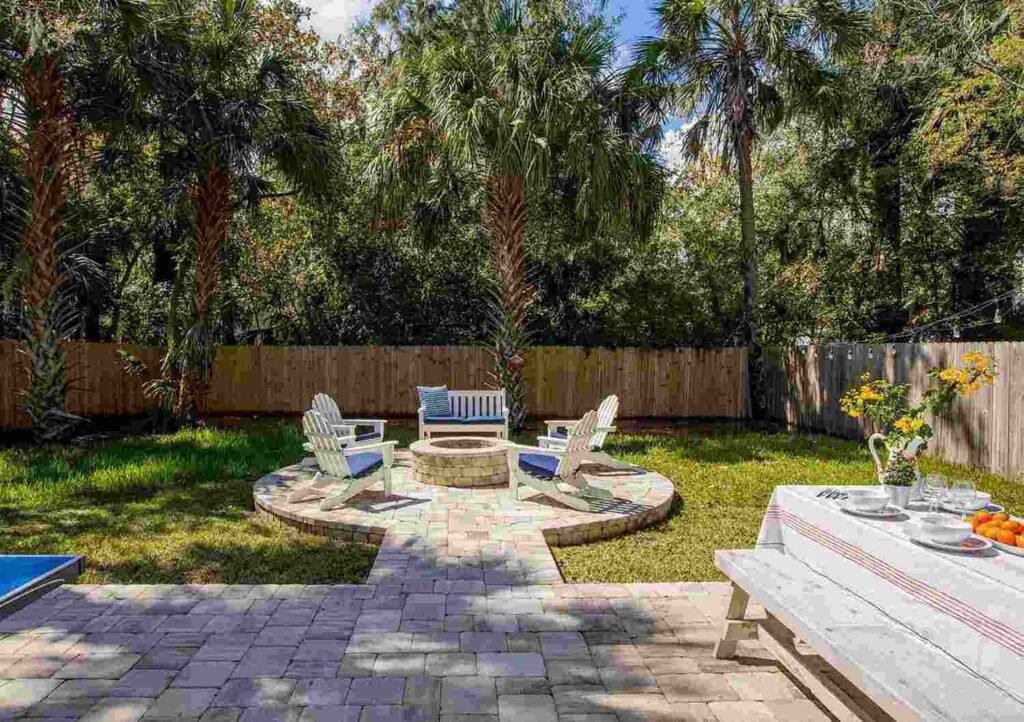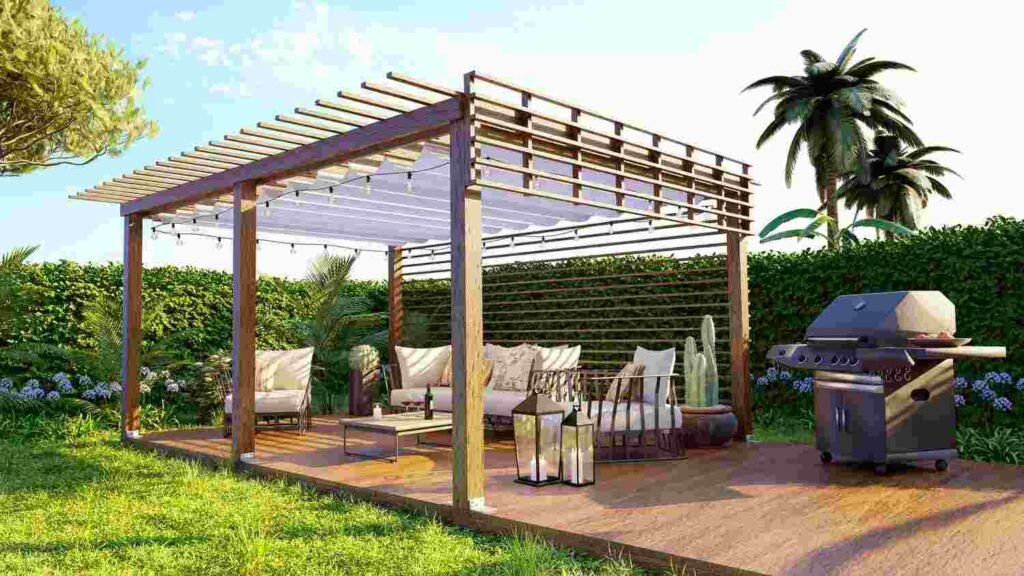Determining whether your property is suitable for hardscaping involves assessing several key factors. Hardscaping, which includes elements like patios, walkways, retaining walls, and other non-plant features, can significantly enhance the aesthetics and functionality of your outdoor space. However, it’s essential to evaluate your property’s terrain, soil composition, drainage, and existing landscaping. Additionally, consider the intended use of the space, your budget, and any local regulations or restrictions. Consulting with the professionals of Evergreen Landscaping of Cincinnati can provide valuable insights and ensure that your vision aligns with the property’s characteristics, ultimately creating a beautiful and practical outdoor living area tailored to your needs.
Property Layout and Space
Assessing the layout and available space of your property is the first step in determining its suitability for hardscaping. Begin by envisioning the hardscaping elements you desire, such as patios, walkways, retaining walls, or outdoor kitchens. Measure the areas where you plan to install these features to ensure there is ample space for each element. Consider how these additions will fit into the overall layout without making the space feel crowded or disjointed.
Think about the flow and functionality of the space. For instance, a well-placed patio near the back door can serve as an extension of your indoor living area, providing easy access for dining and entertaining. Walkways should connect key areas of your yard, such as the garden, garage, or pool, creating a cohesive and accessible landscape. Adequate planning of the layout and space ensures that hardscaping enhances both the aesthetic appeal and usability of your outdoor areas.
Soil Type and Drainage
The soil type and drainage conditions of your property play a critical role in the success of hardscaping projects. Different soil types have varying levels of stability and drainage capabilities, which can affect the longevity and performance of hardscaping elements. Conduct a soil test to determine the composition and characteristics of your soil. This will help you identify any potential issues, such as high clay content, which can lead to poor drainage and foundation instability.
Proper drainage is essential to prevent water pooling and erosion, which can damage hardscape features over time. Ensure that your property has an effective drainage system in place, such as French drains, swales, or dry wells, to manage runoff and direct water away from hardscape structures. Incorporating permeable materials, like porous pavers or gravel, can also enhance drainage and reduce the impact of stormwater on your landscape.
Topography and Slope
The topography and slope of your property significantly influence its suitability for hardscaping. Sloped areas require careful planning to create stable and functional hardscape features. Retaining walls are often necessary to manage elevation changes and prevent soil erosion. These structures not only add visual interest to your landscape but also create level areas for patios, gardens, or play spaces.
When designing hardscaping on a slope, consider the natural flow of water and how it can be managed to prevent erosion and damage. Terracing is a popular solution for steep slopes, allowing for multiple levels of flat, usable space. This approach can create a visually appealing and functional landscape that integrates seamlessly with the natural topography of your property.

Climate and Weather Conditions
Climate and weather conditions are crucial factors in determining the suitability of your property for hardscaping. Hardscaping materials need to withstand the specific weather patterns of your region, including temperature fluctuations, rainfall, and exposure to sunlight. For example, materials like concrete and stone are durable and can handle a wide range of weather conditions, while wood may require more maintenance to prevent rot and decay in wet climates.
Consider the long-term durability and maintenance requirements of the materials you choose. In areas with harsh winters, materials that can resist freeze-thaw cycles are essential to prevent cracking and damage. In hot, sunny climates, materials that reflect heat and resist fading are preferable. By selecting materials appropriate for your local climate, you can ensure the longevity and performance of your hardscape features.
Existing Landscape Features
Evaluating existing landscape features is essential to creating a harmonious blend of hard and soft scapes. Take inventory of the trees, gardens, water features, and other natural elements already present in your yard. These features should complement the hardscaping elements rather than compete with them.
Plan around significant landscape features, such as mature trees, which can provide shade and structure to your design. Incorporating these elements into your hardscape plan can create a more natural and cohesive look. For example, a patio can be designed around the base of a large tree, providing a shaded seating area while preserving the tree’s health and beauty.
Functionality and Purpose
Defining the functionality and purpose of your hardscaping project is crucial to its success. Think about how you intend to use your outdoor space and what activities you want to accommodate. For instance, if you enjoy entertaining, a spacious patio with a built-in grill and seating area may be ideal. If you prefer a peaceful retreat, consider incorporating features like a water fountain, pergola, or garden pathway.
Functional hardscaping can enhance the usability of your yard and improve your quality of life. It can also add value to your property by creating attractive and practical outdoor living spaces. By clearly defining the purpose of your hardscaping project, you can make informed design choices that align with your lifestyle and needs.
Budget and Maintenance
Consider your budget and the maintenance requirements of different hardscaping options. Hardscaping can be a significant investment, so it’s essential to choose materials and designs that fit within your financial constraints. Research the costs associated with various materials, installation processes, and ongoing maintenance to make informed decisions.
Some materials, like natural stone or concrete pavers, may have higher upfront costs but require less maintenance over time. Others, like wood, may be more affordable initially but need regular upkeep to prevent wear and tear. Factor in both the short-term and long-term costs to ensure your hardscaping project is financially sustainable and manageable in terms of upkeep.
Permits and Regulations
Before embarking on a hardscaping project, it’s crucial to understand and comply with local permits and regulations. Many municipalities have specific requirements and codes that govern the installation of hardscape elements such as retaining walls, patios, and outdoor kitchens. These regulations are in place to ensure safety, structural integrity, and environmental protection.
Start by contacting your local building department to inquire about the necessary permits for your project. You may need to provide detailed plans and specifications to obtain approval. Additionally, be aware of any zoning laws or homeowner association rules that might affect your project. Adhering to these regulations not only ensures that your hardscaping is safe and compliant but also helps you avoid potential legal issues and fines.
Professional Assessment
Consulting with a professional landscaper or hardscaping expert can provide invaluable insights into your project’s feasibility and design. Professionals have the experience and knowledge to evaluate your property’s unique characteristics, such as soil composition, drainage, and topography, and recommend appropriate materials and techniques.
A professional assessment can help identify potential challenges and solutions, ensuring that your hardscaping project is both functional and aesthetically pleasing. Experts can also provide design ideas that you might not have considered, maximizing the use of your space and enhancing its overall appeal. Hiring a professional can save you time and money in the long run by preventing costly mistakes and ensuring a high-quality result.
Aesthetic Goals
Your aesthetic goals are an essential consideration when planning a hardscaping project. The design and materials you choose should complement your home’s architecture and the surrounding landscape. Consider the style and atmosphere you want to create—whether it’s a modern, minimalist look, a rustic, natural feel, or a classic, formal design.
Think about how colors, textures, and shapes will work together to create a cohesive and visually appealing space. For example, natural stone can provide a timeless and elegant look, while concrete pavers can offer a sleek and contemporary appearance. Incorporate elements such as lighting, furniture, and decorative accents to enhance the overall aesthetic and create a welcoming outdoor environment.

Environmental Impact
Assessing the environmental impact of your hardscaping project is crucial for promoting sustainability and protecting local ecosystems. Consider using eco-friendly materials and practices that minimize your environmental footprint. Permeable pavers, for instance, allow water to infiltrate the ground, reducing runoff and promoting groundwater recharge.
Additionally, incorporating native plants and xeriscaping techniques can reduce water consumption and support local wildlife. Plan for efficient irrigation systems and use sustainable materials, such as recycled concrete or sustainably sourced wood. By making environmentally conscious choices, you can create a beautiful and sustainable landscape that benefits both your property and the environment.
Long-term Plans
Reflecting on your long-term plans for the property is essential when planning a hardscaping project. Consider how your needs and preferences might change over time and ensure that your hardscaping elements can adapt accordingly. For instance, if you plan to stay in your home for many years, invest in durable materials and designs that will stand the test of time.
If you anticipate selling your property in the future, focus on adding features that enhance curb appeal and property value. Functional and attractive hardscaping can significantly increase the desirability of your home. Think about how the hardscape elements will integrate with future landscaping projects or renovations to create a cohesive and well-maintained outdoor space.
Conclusion:
In conclusion, determining the suitability of your property for hardscaping requires careful evaluation of various factors such as terrain, soil composition, and drainage. By considering the intended use of the space, your budget, and local regulations, you can make informed decisions that align with your vision. Consulting with a professional hardscaping service ensures that all aspects are appropriately addressed, resulting in a cohesive and functional outdoor living area. Whether you’re looking to enhance the aesthetics, improve functionality, or increase the value of your property, proper planning and professional guidance can help you achieve a beautiful and practical hardscape design that meets your needs and preferences.
